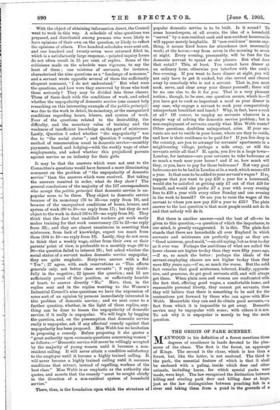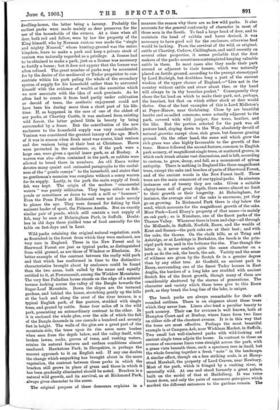THE ORIGIN OF PARK SCENERY.
MANWOOD in his definition of a forest mentions three degrees of excellence in lands devoted to the plea- sures of the chase. The first is the forest, an appanage of Kings. The second is the chase, which is less than a forest, but, like the latter, is not enclosed. The third is the park, the essential feature of which is that it shall be enclosed with a paling, inside which deer and other animals, including hares, for which special parks were made, were kept. The law recognised the distinction between killing and stealing park deer and killing deer at large, just as the law distinguishes between poaching fish in a river and taking them from a pond in the grounds of a
dwelling-house, the latter being a larceny. Probably the earliest parks were made mainly as deer preserves for the use of the households of the owners. At a time when all deer, both red and fallow, were by law the property of the King himself, who by Norman custom was made the "single and mighty Nimrod," whose hunting-ground was the entire kingdom, leave to make a park and keep a private stock of venison was naturally regarded as a privilege. A license had to be obtained to make a park, just as a license was necessary to fortify a house ; but it does not appear that the former was often refused. The great number of parks may be accounted for by the desire of the mediaeval or Tudor proprietor to con- centrate within his park paling the whole of the secondary system of supply for his household rather than to surround himself with the evidence of wealth or the amenities which we now associate with the idea of such precincts. As he often had to create it from land partly under cultivation or devoid of trees, the aesthetic enjoyment could not have been his during more than a short part of his life- time. If, as happened in the case of one of the oldest of our parks, at Chartley Castle, it was enclosed from existing wild forest, the latter gained little in beauty by being surrounded by a fence. But the contribution of the new enclosure to the household supply was very considerable. Venison was considered the greatest luxury of the age. Much of it was in season when fresh meat was scarce, hind venison and doe venison being at their best at Christmas. Hares were protected in the enclosure, or, if the park were a large one, were given a special inner park, as at Bushey. A warren was also often contained in the park, or rabbits were allowed to breed there in numbers. An old Essex writer devotes many quaint and animated paragraphs to the useful- ness of the " gentle coneys " to the household, and states that no gentleman's mansion was complete without a coney warren for its supply. Lastly, in the park the main supply of fresh fish was kept. The origin of the modern " ornamental waters " was purely utilitarian. They began either as fish- ponds or sometimes as dams to work a mill or " hammer." Even the Penn Ponds at Richmond were not made merely to please the eye. They were formed for fishing by that eminent leader of sport, the Princess Amelia. But an exactly similar pair of ponds, which still contain a vast supply of fish, may be seen at Helmingham Park, in Suffolk. Doubt- less in old days these yielded tons of food annually for the table on fast-days and in Lent.
Wild parks retaining the original natural vegetation, such as flourished in the forest from which they were enclosed, are very rare in England. Those in the New Forest and in Sherwood Forest are just as typical parks, as distinguished from wild ground, as are those of Windsor or Blenheim. No better example of the contrast between the really wild park and that which has conformed in time to the distinctive characteristics brought about by enclosure could be found than the two areas, both .called by the name and equally entitled to it, at Powerscourt, among the Wicklow Mountains. The very fine Palladian house stands on the edge of a natural terrace looking across the valley of the Dargle towards the Sugar-Loaf Mountain. Down the slopes are the terraced gardens, and behind the house, stretching gently up the hills at the back and along the crest of the river terrace, is a typical English park, of fine pasture, studded with single trees, and grazed by cattle. Some four miles off is the wild park, presenting an extraordinary contrast to the other. In it is enclosed the whole glen, over the side of which the fall of the Dargle descends in one cascade a hundred and seventy feet in height. The walls of the glen are a great part of the mountain-side, the trees upon its rim seem mere bushes when seen from the depth below, and the valley itself, with broken lawns, rocks, groves of trees, and rushing waters, retains its natural features and surface conditions almost unaltered. Hawkstone Park, in Shropshire, is perhaps the nearest approach to it on English soil. If any one doubts the change which emparking has brought about in the mere vegetation, the contrast between those parks in which the bracken still grows in place of grass and those in which it has been gradually eliminated should be noted. Bracken is a natural wild growth, and its survival, as at Richmond Park, always gives character to the scene.
The original purpose of these demesnes explains in a
measure the reason why there are so few wild parks. It also accounts for the general conformity of character in most of those seen in the South. To feed a large head of deer, and to maintain the head of rabbits and hares desired, it was necessary to have good soil for the enclosure, otherwise feed would be lacking. From the survival of the wild, or original, cattle at Chartley, Cadzow, Chillingham, and until recently on several other properties, it seems probable that the first makers of the parks sometimes contemplated keeping valuable cattle in them. In most cases also they made their park around or adjacent to their houses, which was naturally placed on fertile ground, according to the precept stereotyped by Lord Burleigh, but doubtless long a part of the current wisdom of the upper classes of England,—" Live not in the country without cattle and straw about thee, or thy hand will always be in thy breeches pocket." Consequently they chose the fat land on which to make their park, not, perhaps, the heaviest, but that on which either stock or deer would thrive. One of the best examples of this is Lord Midleton's at Peper-Harow, near Godalming. Close by are beautiful heaths and so-called commons, some actually adjacent to the park, covered with wild juniper, fine trees, heather, and the like. But the portion selected for the park was all pasture land, sloping down to the Wey, absolutely devoid of natural growths except close, rich grass, but famous grazing ground. On the other hand, the same soil which grew the rich grass was also highly favourable to the growth of fine trees. Hence followed the second feature, common to English park scenery, of magnificent single trees, or scattered groves, in which each trunk attains vast dimensions, and is left, according to custom, to grow, decay, and fall, as a monument of sylvan antiquity. There is nothing in England like these magnificent trees, except the oaks and beeches of parts of Sherwood Forest, and of the ancient woods in the New Forest itself. These trees are the main ornament of our typical parks. In nineteen instances out of twenty they are oaks. Given a suitable clayey-loam soil of great depth, there seems almost no limit to their growth or their longevity. At Helmingham, for instance, the average size of the oaks is enormous, yet they go on growing. In Richmond Park there is clay below the sand, which accounts for the magnificent growth of the oaks. Moor Park—Lord Ebury's property of that name—is mainly an oak park ; so is Nuneham, one of the finest parks of the Thames Valley. Wherever there is loam and clay—all through the Midlands, in Suffolk, Norfolk, Essex, and the wealds of Kent and Sussex—the park oaks are at their best ; and with the oaks, the thorns. On the chalk hills, as at Tring and Ashridge, or at Lockinge in Berkshire, the beech is the prin- cipal park tree, and in the bottoms the elm. Fine though the latter is, it never confers quite the same character on a park as do the oak, the beech, the ash. Variety and the sense of wildness are given by the Scotch fir in a greater degree than by any other tree. At Gosfield, an ancient park in Essex, surrounding one of the finest Tudor houses in East Anglia, the borders of a long lake are studded with ancient Scotch firs of the finest growth, though many of them are considerably shattered by the storms of generations. The character and variety which these trees give to this Essex park, as they break the long line of the lake, is unique.
The beech parks are always remarkable for their soft rounded outlines. There is an elegance about these trees which they never lose. Limes also lend a peculiar beauty to park scenery. Their use for avenues is well known, both at Hampton Court and at Bushey, where limes form two lines on either side of the chestnut avenue. It is in this way that the trees are most effective. Perhaps the most beautiful example is at Campses, Ash, near Wickham Market, in Suffolk. Two small but well-timbered parks with wild-looking and ancient single trees adjoin the house. In contrast to these an avenue of enormous limes runs straight across the park, with a grass vista beneath them, each a specimen tree in itself, but the whole forming together a fresh " note" in the landscape. A similar effect, though on a less striking scale, is at Hamp- stead Marshall, the property of Lord Craven, near Newbury. Most of the park, which is fringed by a rushing river, is unusually wild. At one end stood formerly a great palace, built on the model of that at Heidelberg. It was twice burnt down, and only the pairs of enormous gate-piers which marked the different entrances to the gardens remain. The
new house stands on a corresponding tableland divided from the site of the old by broken fern-covered hills, studded with eve)/ species of tree. On the flat are formal avenues of limes, giving the same effect of contrasts as at Campsea Ash.
Among parks of comparatively recent formation are that at. Holkham, studded with ilexes, and surrounded by deep belts of wood, with the park wall outside them, to hold game; and the new park at Lockinge, covering a very large area on the side of the Downs, which has only been planted a few years. Goodwood is famous for its ilexes, and Blenheim for its cedars. It should be noted that in most parks the boughs of the trees are kept clear of the ground by the browsing of cattle or deer, which are very partial to young shoots, and keep the branches at a uniform height.
Park walls and park palings are as ancient as the parks themselves. The typical English park paling of split oak is a beautiful object in itself. In some cases a very ornamental finish is given to it by varying the height of the pales at regular intervals, and running a cross-piece along the top, which lightens the effect of the whole.












































 Previous page
Previous page